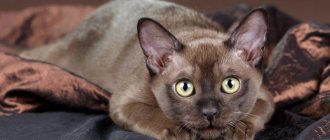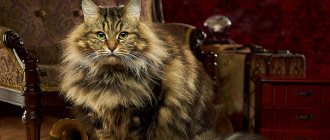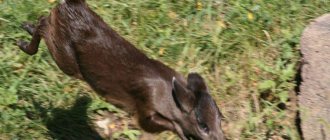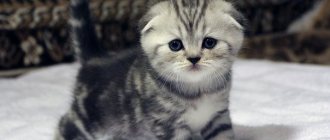The caracal is a wild cat, also known as the steppe lynx. Translated from the Turkic language, caracal means “black ear.” The name speaks for itself; these cats have black backs of their ears. In North Africa, this cat is called the Barbary lynx.
In this article we will tell you: who is a caracal, how much does it cost, how long do caracals live, is it possible to keep them at home, how to care for them, what to feed them, what are the peculiarities of upbringing.
Origin of the breed
At first, caracals were classified as lynxes because of their external similarity, but later scientists discovered some genetic features and identified cats as a separate genus. However, cats are still related to lynxes and have a number of similar characteristics. At the same time, caracals are much closer to pumas in morphological characteristics, and in captivity, black-eared cats are crossed with African servals.
Despite the wild blood, the caracal is easy to tame. He quickly comes into contact with a person and socializes with proper upbringing. In India and Ancient Persia they hunted pheasants, peacocks, hares and antelopes with caracals. The cats were called "little cheetahs" or "poor man's cheetahs" because only wealthy people could afford real cheetahs.
Interesting. Mating a caracal with a domestic cat produces a breed called the caraquet.
In Russia, wild caracals are found in Dagestan. At last count, there were only a few cats left there—about 100 individuals. But given the fact that people still continue the practice of domesticating caracals, cats now live in houses and apartments as pets. Considering the cost of a kitten, which starts from 500 thousand rubles, people with high incomes can buy it.
In nature, there are 9 subspecies of caracal. It is difficult for an ordinary person to notice the differences between them, unlike specialists. African caracals are the most numerous subspecies. Asian cats are critically endangered and are listed as a CITES species. This means that the trade in such animals is tightly controlled. It is impossible to purchase an Asian caracal in licensed Russian nurseries. Breeders are engaged in breeding the domesticated subspecies.
Description and standards of caracal
Above we said that there are 9 subspecies of caracal, although a person far from botany or felinology is unlikely to notice the difference from photographs.
Any steppe lynx is very large and tall. You can’t call her massive: her natural grace cannot be hidden, her heaviness does not catch the eye.
The elongated head is crowned with elongated narrow ears with the most charming tassels at the tips. There is a decent distance between the ears and they stand strictly vertical. On the back of the ears the skin is either flat black or gray.
The body looks lean and short. The tail is shorter than half the body. The graceful caracal moves on high, lean limbs. The paws are massive and large.
The color of the coat is beautiful, reminiscent of ocher mixed with sand. The villi are short and reddish. The fur on the belly and chest is longer. Yellow stripes under the eyes. There are no differences in color between males and females.
Dimensions and weight of caracals
The tall caracal cat reaches half a meter at the withers in adulthood. Pretty solid! The weight of cats reaches 15-21 kg. The weight of females is less than that of males. If such a pet sits on his lap, the owner will immediately feel every kilogram of the handsome man.
Caracal hybrids
Several breeders in Russia, Ukraine and the USA have bred and continue to breed caracal-domestic cat hybrids. Moreover, in the USA the Abyssinian cat is used.
global $ads_google; //data-ad-slot=”2475549904″ $ads_google = empty($ads_google) ? false : true; ?> if ($ads_google == false) {?>
$ads_google = true; ?> } ?>
The experimental breed was named caracat (cara(cal)+cat), which indicates its origin. The first generation hybrid is the most difficult to breed, because the male caracal does not accept representatives of another species for the purpose of reproduction. But breeders are persistent; today there are cats in the world that look like caracals, with an affectionate character and smaller dimensions.
For some reason, dogs don’t perceive Carket as a cat. For them, this is a creature equivalent to them, and relationships are built on the dog-dog principle
Another hybrid is the servical, or ser-caracal. In this case, breeders took a male from a serval and a female from a caracal. The cat's appearance resembles a serval, and its ears come from Caracal blood. This is a completely new breed, a pure experiment.
Caracals in the wild
Not everyone knows where the caracal lives, but we will tell you! The natural environment of caracals is savannah, steppe, desert, foothills of Africa, as well as the deserts of the Arabian Peninsula, Asia, and the Middle East. In the CIS, cats are found in the territory of Southern Turkmenistan, the coast of the Caspian Sea, and in the east of Kyrgyzstan. In 2022, employees of the Environmental Protection Agency, which is located in Abu Dhabi, discovered the first caracal for the first time. Before this, the predator had not been seen in the UAE for 35 years.
Caracals are active at night, but in winter and spring they stick out their sensitive noses during the day. As a home, they choose rock crevices and fox holes, in which they live for several years in a row. Males “own” vast territories, females are content with little - they are located on the periphery.
Long legs allow you to quickly gain speed, but do not affect endurance in any way. Caracals cannot run as long as other wild cats can. Therefore, black-eared beauties hunt stealthily: they track the prey and overtake it with long (4-4.5 m in length) jumps. In addition, caracals have lightning-fast reactions and retractable claws that are sharp, like scalpels.
This allows predators to pluck several birds from a flying flock. However, the main diet of caracals consists of jerboas, gerbils, ground squirrels, tolai hares, antelopes, and goitered gazelles. Occasionally cats snack on hedgehogs, porcupines, lizards, insects, foxes, mongooses, and young ostriches. They may also steal poultry, lambs and goats. Caracals are able to live without water for several days, or even weeks, receiving life-giving moisture from food.
Interesting. The caracal hides its prey in the trees, like a leopard.
Appearance of a caracal
Externally, caracals are similar to lynxes, but they are smaller, look slimmer, and their fur is colored the same tone. Body length 65-82 cm, tail - 25-30 cm, height - 43-45 cm, all - 10-20 kg. The length of the ears with tassels is 4-5 cm. Tufts of coarse hair stick out between the fingers. This makes it easier to move around the sand dunes.
The coat is short and very thick. The main color is sandy or reddish brown. The belly is whitish. There are dark marks on the sides of the muzzle. The tufts and back of the ears are black. There are also blue-black melanistic caracals, but seeing them in their natural habitat is a great success.
Breed standards
Each cat species has its own standard characteristics. Caracal is no exception:
- Origin: Africa, Asia.
- Year: approximately 1766.
- Dimensions: large.
- Group affiliation: wild species.
- Average weight: male 14-20 kg, female 9-13 kg.
- Coat color: honey brown. Ear tassels are black.
- Wool: very dense, thick and soft.
- Temperament and character: active, loves water, nocturnal. Requires socialization.
Features of character and behavior
Domestic caracals from an elite nursery are well-bred and, as a rule, do not cause much trouble to their new owners. The menacing appearance and impressive size mislead people; many people think that wild blood certainly affects temperament and character, and that it is almost impossible to control a caracal. In fact, caracals turn out to be absolutely calm, balanced, obedient and friendly animals.
They love and respect their owners, and are always ready to protect them from ill-wishers. Cats are distrustful of strangers. First, they need to sniff the stranger and determine his intentions with an experienced eye. If everything is fine with the guest, the caracal will welcome him on its territory. Owners of the breed note the developed intuition of their pets. Animals immediately determine with what intentions a person has come.
Caracals are playful and active at home. The owner must be on the same level as his ward and get involved in the game on time, otherwise the cat will find something to do with itself. At the same time, there is no need to play the caracal too much, otherwise harmless pranks may end in injury to one or both participants in the game.
Representatives of the breed, like small children, need the care and attention of their “mother.” The owner always plays this role. Cats are easy to raise and train. But if they don’t like something, they can use their claws and teeth. For example, if you see that your pet is tired of playing, leave him alone. He can’t voice his condition, but he can easily paw at him! This is why breeders do not recommend playing with caracals with your hands. Instead, it is better to buy a toy in the form of a pendant at a pet store or make one yourself.
A domestic caracal with a stable psyche does not deliberately show aggression, but families with small children should be careful and not get a cat until the child reaches an age when the rules of handling the steppe lynx can be explained to him.
These animals are smart and quick-witted, quickly accustomed to the tray, come when called, responding to their name, and carry out simple commands.
The steppe lynx gets along well with dogs and other cats, but perceives birds and small animals as prey.
Brief description of the breed
A cat with an amazingly beautiful color is called a steppe lynx: its legs are long and fast, and there are tassels on the tips of its black ears. These cats live in African and Asian territories, choosing steppe plains.
The caracal is a true hunter who prefers to hunt at night. Its food consists of small rodents, birds and mammals. He does not disdain small livestock either. Because of this, it is now in danger of extinction. Because it exterminated livestock, it was actively hunted, which seriously reduced the population.
The caracal is a very beautiful species of the cat family: a fast runner and an excellent swimmer. His appearance is very memorable: a small elongated muzzle, which is decorated with black and white spots; large ears with black tassels at the ends; almond-shaped eyes with yellow irises; thick dense wool of brown color, and light weight of 15-20 kg.
Maintenance and care
If the caracal's habitat is city apartments, walk the cat daily on a leash. Fresh air is vital for him. But breeders still advise owners of private houses to own caracals, because a large animal needs space.
Caracals can be very clumsy. Sometimes the room after games resembles a battlefield: broken vases and flowers, scratched wallpaper and furniture upholstery. If possible, equip a playroom in your home with an area of about 15 square meters. m with various climbing frames, Swedish slides, and a scratching post.
The pet's home should look like an enclosed space with an adjoining enclosure, from which you can go out onto the garden plot. The area of the house must be fenced off so that the cat cannot escape in an unknown direction. Pay attention to the heat-loving nature of caracals. These cats cannot tolerate cold at all, so their home must be heated.
Adult males and females mark territory. Breeders have long come to terms with this, but new owners will have to spay or neuter their pet at 3-5 months if you are not going to breed.
Thick and dense wool with a padded undercoat sheds all year round, and especially heavily in the summer. The pet will have to be combed 3-4 times a week and bathed once every 4-6 months. The caracal grinds its claws down on its own, but you can trim them if you wish. You are taught the procedure from an early age, otherwise you won’t be able to get your hands on a cat later.
Important! Caracals, like many other wild animals, are keenly interested in foreign objects and often try out interesting finds. Therefore, breeders strongly recommend removing objects that the steppe lynx can swallow from the field of view. Often it ends up on the operating table!
Nutrition
Caracals eat three times more than regular house cats. And this is not surprising - just look at the size of the animal! Cats prefer fresh meat from broiler chickens, whole quail carcasses with feathers, beef, turkey, and will not refuse to crunch on rodents. You can give sea fish after removing the bones.
Fresh vegetables are served with meat and fish: zucchini, pumpkin, cabbage, carrots. Fermented milk products and raw eggs are offered 1-2 times a week
Industrial food is not the best food for these animals, even if it is labeled “for large breeds.” Do not feed your domestic lynx lamb and pork. The first is too fatty for him, and eating pork leads to infection with Aujeszky's disease - infectious paralysis or itchy plague. The list of prohibited foods also includes whole milk, soups, table foods and cereals.
The optimal diet for the Caracal cat breed is as follows: kittens - twice a day, adults - once. The amount of food varies depending on the age of the animal, but in any case it should be impressive. Food must be served at the same time. If the cat has not finished eating, the leftovers are thrown away and the bowls are washed. Once a week it is recommended to arrange fasting days. Clean, cool water should always be available! This needs to be monitored as caracals drink a lot.
After the meal, the room will resemble the arena of the Colosseum during a gladiator battle: bones, feathers, blood, meat everywhere. The future owner will have to clean the eating area every day.
Health and how long they live
In-person visits to the veterinarian should be carried out twice a year, and the carcal should be vaccinated against rabies and other dangerous infectious diseases on time. Steppe lynxes have excellent health and rarely get sick, but if your pet still feels unwell, you should not self-medicate. Regular brushing of the coat will help prevent the development of stomach problems. Let us indicate how long caracals live. The average life expectancy is 15-20 years.
Upbringing
Caracals begin to be raised at 3-4 months of age. First of all, your pet needs to be accustomed to the scratching post in order to preserve the furniture and wallpaper.
You need to communicate with the animal every day and not ignore it. Socialization is the most important point in raising representatives of this breed, otherwise wild genes will begin to dominate. Surround your pet lynx with care and love, and he will thank you in kind.
Price and where to buy a caracal kitten
The demand for domestic caracal is very high. There are many people who are willing to part with a large sum of money for the sake of a coveted extravagant pet in their home. Including the upcoming costs of transportation and maintenance, the amount turns out to be quite substantial.
global $ads_google; //data-ad-slot=”2475549904″ $ads_google = empty($ads_google) ? false : true; ?> if ($ads_google == false) {?>
$ads_google = true; ?> } ?>
First, a nursery is selected: you need to inquire about official documents. Nursery owners always issue all documents for the animal, and also provide various consultations on the care and training of the caracal.
Due to the natural characteristics of the breed, a cat should be purchased at the age of 4-5 months. Before purchasing, visit the nursery and study the conditions of keeping the animals, the nuances of feeding and walking. If the nursery is home, then this is an advantage: the kitten is kept next to a person from childhood, it will be easier for him to survive relocation to a new home.
The kittens are examined, examining the fur, the cleanliness of the eyes and ears. There should be no discharge. You can watch the cat spend its time and find out its reaction to people.
The price of a caracal kitten is 400,000-450,000 rubles
, Kotofeya is bought abroad for
6,000-8,000 dollars
. Cats are more expensive in price than cats. This cost is due to the fact that the animals are not so easy to raise and breed.
How to name kittens
Naming a young caracal is not easy. You certainly can’t call him Vasya. You can ask about the names of the area where the cat’s ancestors come from. Maybe this will give the new owner an original idea. The name of an animal cannot be very complex and dissonant. This is a representative of the feline species, which means that hissing names will still be welcome.
The domestic caracal should be named exotically, but in a way that emphasizes its nature and beauty.
We offer a list of names for boys and girls; you can choose a ready-made nickname. Nickname table
| Girl | Boy | ||
| Sparkle Unit Alani Lucien Daisy Hannah Gata Mystery Aurora Fanta | Eva Laina Zlata Lika Marta Pamela Larry Isa Gerda Zvezda | Red Martyn Aman Shaitan Mirage Markus Luntik Felix Remmy Adis | Lapsus Kiryan Almaz Harison Cupcake Uncas Milan Velez Archie Richie |
Breeding
In the wild, caracals breed year-round. The female usually has 2-3 partners. Pregnancy lasts 78-81 days, after which 1 to 6 kittens are born. Over the course of a month, the mother cat changes her den several times. As soon as young caracals turn six months old, they leave their home and go in search of their own. Sexual maturity occurs at 16-18 months. The most suitable age for finding sexual partners is 14-15 months.
Domesticated female caracals also give birth several times a year. However, breeders do not allow their cats to become pregnant more than once a year to maintain their health. Up to four babies are rarely born in a litter, often two.
How to choose a kitten
It is recommended to buy a caracal kitten from home-type nurseries. Cats are in constant contact with people and are characterized by the highest level of socialization. However, this does not guarantee that the caracal will be docile and affectionate. And you need to remember this!
The breeder must have a breeding license, the nursery must be clean, the cats must be healthy, each pet must have a package of documents, a veterinary passport, and a CITES certificate. In addition, the buyer signs a purchase and sale agreement, receives an acceptance certificate and a microchip.
When choosing a kitten, pay attention to its behavior and appearance. The fur coat, mucous membranes of the eyes, ears, the area under the tail should be clean, the belly should be soft. The baby should be active, keenly interested in what is happening, and respond to sounds, for example, the ringing of keys.
What does the price depend on?
This breed is one of the five most expensive. When purchasing, there are many nuances and sometimes you don’t know how much a caracal cat costs. It is not easy to choose where to buy a kitten: from professionals or in a nursery. The choice is made easier by the fact that there are about 5 such nurseries around the world.
Breeders must have some experience in this matter, at least 5 years. It’s easier for foreign nurseries: they must have a special license to breed kittens. It is more difficult for Russian breeders: before starting breeding, they must fulfill the necessary conditions:
- Be a member of several organizations for breeding rare breeds of cats.
- Have the necessary documents on hand, including a pet card, veterinary passport, etc.
The future owner needs to take into account the following nuances:
- It is better to purchase a kitten rather than an adult animal. An adult is more difficult to tame. The kitten must be no more than six months old.
- The pet must be healthy: thick and shiny fur, clean skin, without any discharge.
- A kitten that has grown up in a nursery must be kept without an enclosure .
In different regions the price is different. At the nursery, the cost increases several times. Its increase is influenced by several points:
- Purity of the breed.
- Age.
- The place where the pet is purchased.
- The level of reputation of the establishment or breeder.
- Experience.
- Is there a veterinary passport and card for the caracal?
- Feline health.
Attention! If you are going to purchase a purebred breed rather than a hybrid, the price will be increased. This also applies to having a passport and card.
What is the price
In Russia, caracal kittens are sold for an average of 500 thousand rubles. From some breeders you can buy 100-150 thousand cheaper or, conversely, more expensive. The final price depends on the purebred, the location of the nursery, the age and health of the animal, the reputation of the breeder, and the availability of related documents. Purebreds are more expensive, domestic cat-caracal hybrids are cheaper. The smaller the baby, the higher its cost and vice versa. Particularly valuable cats cost from 10,000 to 50,000 US dollars.
Pros and cons of the breed
Advantages of a Caracal cat:
- exotic appearance;
- flexible character;
- affectionate disposition;
- good health;
- activity;
- playfulness;
- easy care;
- high intellectual abilities;
- tendency to train.
Flaws:
- without proper attention from the owner, wild genes appear in the cat;
- high price;
- costly maintenance;
- a private house is more suitable for living;
- It is not recommended for families with small children.











